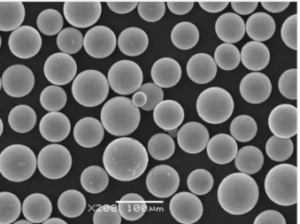مسحوق فولاذي عالي القوة هي مادة تلعب دورًا حاسمًا في مختلف الصناعات، بدءًا من صناعة السيارات وحتى صناعة الطيران. وقد مكنت خصائصه الفريدة، جنبًا إلى جنب مع التطورات التكنولوجية، المهندسين والمصنعين من إنشاء مكونات ليست فقط أقوى ولكن أيضًا أخف وزنًا وأكثر متانة. في هذا الدليل الشامل، سوف نتعمق في هذا الدليل الشامل في ماهية مسحوق الفولاذ عالي القوة وتركيبته وخصائصه وتطبيقاته وغير ذلك الكثير. لذا، سواءً كنت محترفًا متمرسًا أو مجرد فضولي، ابق معنا - ستكون هذه رحلة غنية بالمعلومات.
نظرة عامة على مسحوق الصلب عالي القوة
مسحوق الفولاذ عالي القوة هو شكل من أشكال المسحوق المعدني المصمم خصيصًا لتوفير خصائص ميكانيكية استثنائية، مثل قوة الشد العالية والصلابة ومقاومة التآكل والتعب. عادةً ما يستخدم هذا المسحوق في تقنيات التصنيع المتقدمة مثل التصنيع الإضافي (الطباعة ثلاثية الأبعاد)، ومسحوق المعادن، وصب حقن المعادن، حيث تسمح حبيباته الدقيقة بتشكيل أشكال دقيقة ومعقدة.
يتم إنتاج مساحيق الصلب عالية القوة من خلال طرق مختلفة، بما في ذلك الانحلال، الذي ينطوي على تفتيت الصلب المنصهر إلى قطرات صغيرة تتصلب في شكل مسحوق. يمكن تصميم التركيبة المحددة للمسحوق لتلبية متطلبات التطبيقات المختلفة، بدءًا من قطع غيار السيارات عالية المتانة إلى مكونات الطيران خفيفة الوزن.
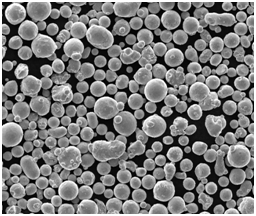
أنواع مسحوق الفولاذ عالي القوة والتركيب والخصائص والخصائص
| الطراز | التركيب | الخصائص | صفات |
|---|---|---|---|
| HSLA-100 | الحديد، والكربون، والمنغنيز، والنيكل، والكروم | قوة الشد العالية، ومقاومة التآكل | ممتاز للتطبيقات البحرية، قابل للحام |
| CPM 3V | الحديد، والكربون، والفاناديوم | صلابة استثنائية ومقاومة للتآكل | مثالية لأدوات القطع والأجزاء البالية |
| مارينج 300 | الحديد، والنيكل، والنيكل، والكوبالت، والموليبدينوم | قوة خضوع عالية وقابلية لحام جيدة | مناسبة للفضاء، والتروس عالية الأداء في مجال الطيران |
| 17-4 PH | الحديد، والكروم، والنيكل، والنيكل، والنحاس | قوة عالية ومقاومة للتآكل | تُستخدم في الفضاء، والمعالجة الكيميائية |
| إيرميت 100 | الحديد والنيكل والنيكل والكوبالت والكروم | متانة فائقة وصلابة في الكسر | تستخدم في معدات الهبوط، والهياكل الفضائية |
| فولاذ الأدوات H13 | الحديد، الكربون، الكروم، الكروم، الفاناديوم | صلابة عالية، ومقاومة للإجهاد الحراري | شائع في أدوات الصب بالقالب والبثق |
| S136H | الحديد، والكربون، والكروم | صلابة عالية ومقاومة للتآكل | يستخدم في القوالب البلاستيكية، قابلية تلميع ممتازة |
| فولاذ M300 مارينج ستيل | الحديد، والنيكل، والنيكل، والكوبالت، والموليبدينوم | قوة عالية، ليونة جيدة | مناسبة للتطبيقات عالية الضغط |
| فولاذ الأدوات D2 | الحديد، الكربون، الكروم، الكروم، الفاناديوم | صلابة عالية، مقاومة للتآكل | مثالية لختم وتشكيل الأدوات |
| PMD-100 | الحديد، والكربون، والموليبدينوم، والنيكل | صلابة متوازنة ومقاومة للتآكل | متعدد الاستخدامات للاستخدامات الصناعية والسيارات |
تكوين مسحوق الفولاذ عالي القوة
يتم تصميم تركيبة مسحوق الصلب عالي القوة بعناية لتحقيق خصائص ميكانيكية محددة. وتشمل العناصر الشائعة المستخدمة في هذه المساحيق الحديد والكربون والكروم والنيكل والنيكل والفاناديوم والكوبالت والموليبدينوم. ويساهم كل عنصر في الأداء الكلي للمسحوق:
- الحديد (Fe): المكوّن الأساسي في الفولاذ، حيث يوفر الهيكل الأساسي.
- الكربون (C): يزيد من الصلابة والقوة من خلال تكوين الكربيدات.
- الكروم (Cr): يعزز مقاومة التآكل والصلابة.
- النيكل (ني): يحسّن المتانة ومقاومة الصدمات.
- الفاناديوم (V): يزيد من مقاومة التآكل والقوة في درجات الحرارة العالية.
- الكوبالت (Co): يحسن الثبات في درجات الحرارة العالية والخصائص المغناطيسية.
- الموليبدينوم (Mo): يعزز القوة والصلابة، خاصةً في درجات الحرارة المرتفعة.
يتم دمج هذه العناصر بنسب متفاوتة لإنشاء مساحيق الصلب التي تلبي احتياجات تطبيقات محددة. على سبيل المثال، يزيد المحتوى العالي من الكربون من الصلابة، في حين أن إضافة الكروم يمكن أن يعزز بشكل كبير من مقاومة التآكل، مما يجعل مسحوق الصلب مناسبًا للاستخدام في البيئات القاسية.
خصائص مسحوق الصلب عالي القوة
يتم تعريف مساحيق الصلب عالية القوة من خلال مجموعة فريدة من الخصائص، والتي تشمل:
- قوة شد عالية: تم تصميم هذه المساحيق لتحمل قوى الشد أو السحب الكبيرة دون أن تنكسر.
- مقاومة التآكل: العديد من مساحيق الفولاذ عالية القوة مقاومة للصدأ وأشكال التآكل الأخرى، مما يجعلها مثالية للاستخدام في البيئات البحرية أو الكيميائية.
- مقاومة التآكل: غالبًا ما تستخدم مساحيق الفولاذ عالية القوة في التطبيقات التي تواجه فيها المادة تآكلًا ميكانيكيًا متكررًا.
- مقاومة التعب والإجهاد: تُعد القدرة على تحمل التحميل الدوري دون حدوث عطل أمرًا بالغ الأهمية للمكونات التي تتعرض لإجهاد متكرر.
- الصلابة: يمكن معالجة هذه المساحيق لتحقيق مستويات صلابة عالية جدًا، مما يجعلها مناسبة لأدوات القطع والقوالب.
- الليونة: على الرغم من قوتها، فإن العديد من هذه المساحيق تحافظ على ليونة جيدة، مما يسمح بتشكيلها وتشكيلها دون تشقق.
هذه الخصائص تجعل مساحيق الفولاذ عالية القوة لا غنى عنها في الصناعات التي تكون فيها المتانة والدقة والموثوقية ذات أهمية قصوى.
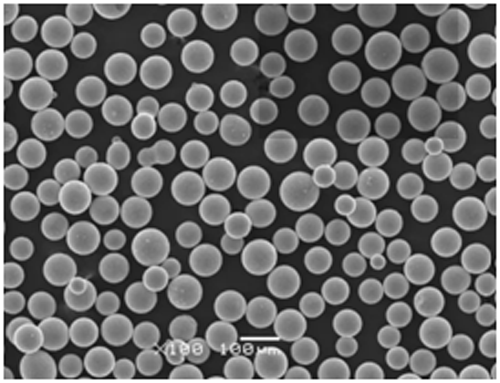

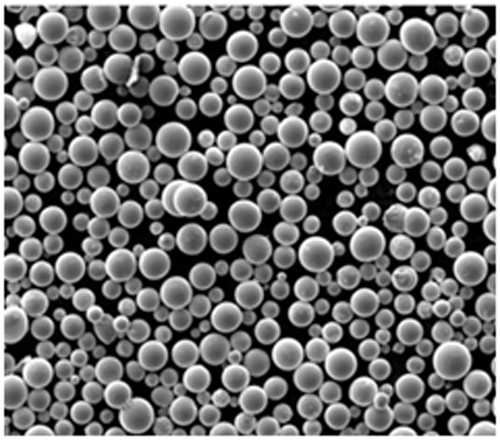
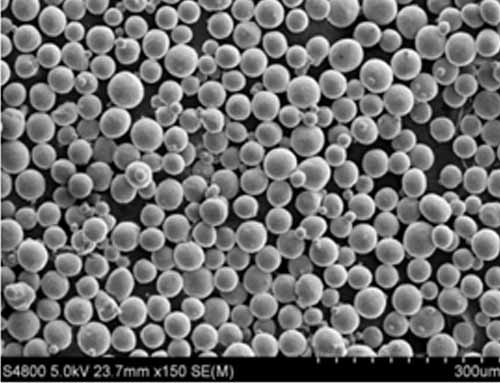
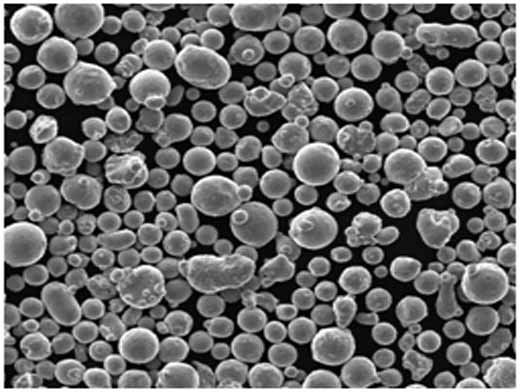
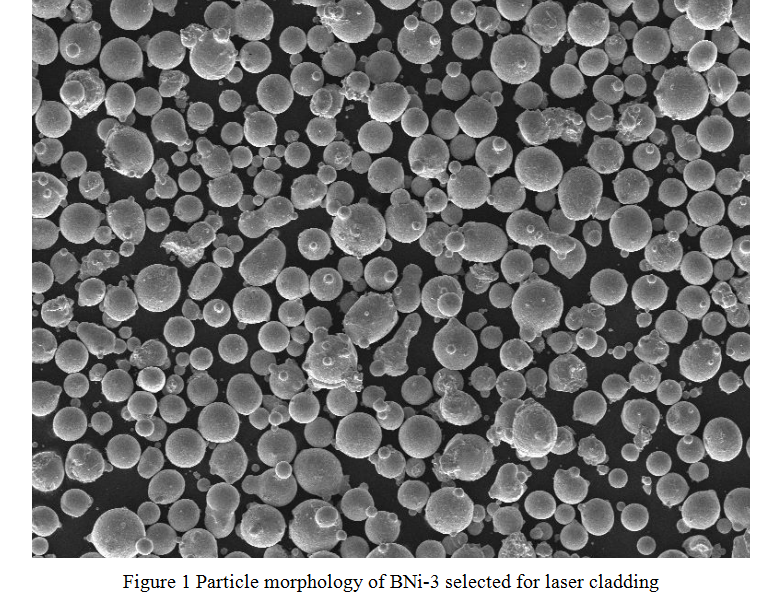
تطبيقات مسحوق الفولاذ عالي القوة
إن تعدد استخدامات مساحيق الصلب عالية القوة يسمح باستخدامها في مختلف الصناعات، ويستفيد كل منها من خصائصها الفريدة. إليك كيفية استخدام هذه المساحيق في قطاعات مختلفة:
صناعة السيارات:
- مكونات هيكلية عالية القوة: يُستخدم في إنتاج هياكل وأجزاء جسم خفيفة الوزن وقوية في نفس الوقت.
- أجزاء المحرك: يوفر مقاومة للتآكل في المكونات الحرجة مثل أعمدة الكامات والتروس.
صناعة الطيران والفضاء:
- معدات الهبوط: إن القوة والصلابة الفائقة لمساحيق معينة مثل Aermet 100 تجعلها مثالية لمكونات معدات الهبوط.
- المكونات الهيكلية: تُستخدم في هياكل الطائرات حيث تكون نسب القوة إلى الوزن العالية ضرورية.
الأدوات والقولبة:
- قوالب الصب بالقالب: تُعد المساحيق مثل فولاذ الأدوات H13 مثالية بسبب مقاومتها للإجهاد الحراري.
- القولبة بالحقن: يُفضل استخدام مسحوق الفولاذ S136H في القوالب البلاستيكية التي تتطلب قابلية تلميع عالية ومقاومة للتآكل.
التطبيقات البحرية:
- أجزاء مقاومة للتآكل: يشيع استخدام HSLA-100 في الهياكل البحرية نظرًا لقابليته الممتازة للحام ومقاومته للتآكل في مياه البحر.
- معدات الحفر البحري: إن الجمع بين القوة ومقاومة التآكل يجعل هذه المساحيق مثالية للبيئات البحرية القاسية.
الآلات الصناعية:
- أجزاء التآكل: يوفر مسحوق الفولاذ CPM 3V مقاومة فائقة للتآكل، مما يجعله مناسبًا لأدوات القطع والآلات الصناعية.
- تروس للخدمة الشاقة: يستخدم في تصنيع التروس التي تتطلب قوة ومتانة في آن واحد.
الأجهزة الطبية:
- الأدوات الجراحية: تُعد الصلابة العالية ومقاومة التآكل أمرًا بالغ الأهمية في الأدوات الطبية، مما يجعل مساحيق الفولاذ عالية القوة خيارًا مفضلاً.
- غرسات تقويم العظام: إن التوافق الحيوي والقوة التي تتمتع بها بعض المساحيق تجعلها مثالية للغرسات الحاملة.
تطبيقات واستخدامات مسحوق الفولاذ عالي القوة
| الصناعة | طلب | الطراز/النوع | سبب استخدامه |
|---|---|---|---|
| السيارات | المكونات الهيكلية | HSLA-100 | قوة عالية وخفيفة الوزن |
| أجزاء المحرك | CPM 3V | مقاومة التآكل | |
| الفضاء | معدات الهبوط | إيرميت 100 | قوة وصلابة عالية للغاية |
| المكونات الهيكلية | مارينج 300 | نسبة عالية من القوة إلى الوزن | |
| الأدوات والقولبة | قوالب الصب بالقالب | فولاذ الأدوات H13 | مقاومة الإجهاد الحراري |
| القولبة بالحقن | S136H | قابلية عالية للتلميع، ومقاومة التآكل | |
| البحرية | الأجزاء المقاومة للتآكل | HSLA-100 | قابلية اللحام ومقاومة مياه البحر |
| معدات الحفر البحري | إيرميت 100 | المتانة ومقاومة التآكل | |
| الآلات الصناعية | أجزاء التآكل | CPM 3V | مقاومة فائقة للتآكل |
| تروس للخدمة الشاقة | فولاذ الأدوات D2 | القوة والمتانة | |
| الأجهزة الطبية | الأدوات الجراحية | 17-4 PH | الصلابة ومقاومة التآكل |
| غرسات تقويم العظام | فولاذ M300 مارينج ستيل | التوافق الحيوي والقوة |
المواصفات والأحجام والدرجات والمعايير
يعد فهم مواصفات مساحيق الفولاذ عالي القوة وأحجامها ودرجاتها ومعاييرها أمرًا ضروريًا لاختيار المادة المناسبة لتطبيقك. فيما يلي جدول تفصيلي يلخص هذه الجوانب.
الجدول: المواصفات والأحجام والدرجات والمعايير الخاصة بمساحيق الصلب عالية القوة
| الطراز | المواصفات | الأحجام المتوفرة | درجات | المعايير |
|---|---|---|---|---|
| HSLA-100 | قوة الشد: 690 ميجا باسكال | 5 ميكرومتر - 150 ميكرومتر | الصف 80 | ML-S-16216K، A710-ASTM A710 |
| CPM 3V | الصلابة: 58-60 HRC | 10 ميكرومتر - 100 ميكرومتر | الدرجة أ | ASTM A681 |
| مارينج 300 | قوة الخضوع: 1930 ميجا باسكال | 20 ميكرومتر - 120 ميكرومتر | الصف 300 | AMS 6514 |
| 17-4 PH | قوة الشد: 1170 ميجا باسكال | 15 ميكرومتر - 125 ميكرومتر | H900، H1025 | AMS 5643، ASTM A564 |
| إيرميت 100 | قوة الشد: 2070 ميجا باسكال | 10 ميكرومتر - 150 ميكرومتر | الصف 100 | MIL-S-46119 |
| فولاذ الأدوات H13 | الصلابة: 50-52 HRC | 10 ميكرومتر - 90 ميكرومتر | الدرجة أ | ASTM A681 |
| S136H | صلابة 48-52 HRC | 5 ميكرومتر - 100 ميكرومتر | الصف S136 | معيار DIN 1.2083، GB/T 1220 |
| M300 مارينج | قوة الشد: 2050 ميجا باسكال | 20 ميكرومتر - 120 ميكرومتر | الصف 300 | AMS 6514 |
| فولاذ الأدوات D2 | الصلابة: 55-62 HRC | 15 ميكرومتر - 110 ميكرومتر | الدرجة أ | ASTM A681 |
| PMD-100 | قوة الشد: 750 ميجا باسكال | 20 ميكرومتر - 130 ميكرومتر | الصف 100 | أستم f75، أم أس 5758 |
تفاصيل الموردين والأسعار
يمكن أن تختلف أسعار مساحيق الصلب عالية القوة اختلافًا كبيرًا حسب التركيب والجودة والمورد. فيما يلي مقارنة بين بعض الموردين الشائعين ونطاقات أسعارهم.
الجدول: تفاصيل الموردين والأسعار لمساحيق الصلب عالية القوة
| المورد | الطراز | سعر الكيلوغرام (بالدولار الأمريكي) | الحد الأدنى لكمية الطلب (كجم) | خيارات الشحن |
|---|---|---|---|---|
| المساحيق المعدنية المتقدمة | HSLA-100 | $50 – $75 | 10 | شحن عالمي، معجّل |
| مستلزمات ستيل تك | CPM 3V | $80 – $110 | 5 | محليًا ودوليًا |
| شركة السبائك الدقيقة | مارينج 300 | $120 – $150 | 2 | الشحن السريع متاح |
| المساحيق المعدنية المباشرة | 17-4 PH | $60 – $90 | 20 | خصومات بالجملة، شحن عالمي |
| Aerospace Materials Ltd. | إيرميت 100 | $200 – $250 | 1 | خيارات الشحن المخصصة |
| حلول أدوات الصلب | فولاذ الأدوات H13 | $70 – $100 | 15 | محلي فقط |
| جلوبال بودرة المعادن العالمية | S136H | $90 – $130 | 10 | شحن عالمي، معجّل |
| ماراجينج ميتالز ذ.م.م. | M300 مارينج | $140 – $180 | 5 | الشحن السريع متاح |
| مساحيق الصلب الصناعية | فولاذ الأدوات D2 | $85 – $120 | 8 | خصومات بالجملة، دولية |
| شركة PowderMet Inc. | PMD-100 | $55 – $80 | 25 | شحن عالمي، خصومات بالجملة |
مزايا ومحدودية مساحيق الصلب عالية القوة
توفر مساحيق الصلب عالية القوة العديد من الفوائد، ولكنها تأتي أيضًا مع بعض القيود. وفيما يلي تفصيل ذلك:
الجدول: مزايا ومحدودية مساحيق الصلب عالية القوة
| مزايا | محددات |
|---|---|
| نسبة قوة إلى وزن عالية | يمكن أن يكون أغلى من الفولاذ التقليدي |
| مقاومة ممتازة للتآكل | يتطلب عمليات تصنيع دقيقة |
| مقاومة فائقة للتآكل | قد تحتاج إلى معدات متخصصة للتعامل معها |
| تعدد الاستخدامات عبر التطبيقات | التوفر المحدود لبعض الدرجات المحددة |
| مقاومة جيدة للإجهاد والتعب | قد يمثل تحضير المسحوق وتخزينه تحدياً |
| سهولة السبك والتخصيص | احتمالية وجود مسامية في الأجزاء الملبدة |
| الفوائد البيئية في التصنيع | قابلية إعادة التدوير المحدودة لبعض المساحيق عالية السبائك |

التعليمات
| سؤال | الإجابة |
|---|---|
| فيم يستخدم مسحوق الصلب عالي القوة؟ | يُستخدم في صناعات مثل السيارات، والفضاء، والأدوات، والصناعات البحرية، والطبية للأجزاء التي تتطلب قوة عالية، ومقاومة للتآكل، ومقاومة للتآكل. |
| كيف يُصنع مسحوق الصلب عالي القوة؟ | يتم إنتاجه عادةً عن طريق الانحلال، حيث يتم تكسير الفولاذ المنصهر إلى قطرات دقيقة تتصلب إلى مسحوق. |
| ما هي فوائد استخدام مسحوق الفولاذ عالي القوة؟ | تشمل المزايا قوة الشد العالية، ومقاومة التآكل، ومقاومة التآكل، والقدرة على تشكيل أشكال معقدة. |
| هل يمكن إعادة تدوير مسحوق الصلب عالي القوة؟ | في حين يمكن إعادة تدوير بعض مساحيق الصلب عالية القوة، إلا أن تلك التي تحتوي على تركيبات سبائك معقدة قد تشكل تحديات. |
| هل مسحوق الفولاذ عالي القوة مناسب للطباعة ثلاثية الأبعاد؟ | نعم، يتم استخدامه على نطاق واسع في التصنيع المضاف نظرًا لقدرته على إنتاج مكونات دقيقة ومعقدة. |
| ما هي الدرجات الشائعة لمسحوق الصلب عالي القوة؟ | تشمل الدرجات الشائعة HSLA-100، وCPM 3V، وMaraging 300، و17-4 PH، وAermet 100، وغيرها. |
| كيف يمكن مقارنة مسحوق الفولاذ عالي القوة بالفولاذ التقليدي؟ | يوفر مسحوق الفولاذ عالي القوة خواص ميكانيكية فائقة ومرونة في التصنيع ولكنه قد يكون أكثر تكلفة ويتطلب تقنيات معالجة متقدمة. |
| ما هي الصناعات الأكثر استفادة من مسحوق الصلب عالي القوة؟ | تستفيد صناعات مثل صناعة الطيران والسيارات والملاحة البحرية والأدوات وتصنيع الأجهزة الطبية بشكل كبير من استخدام مساحيق الصلب عالية القوة. |
| كيف يجب تخزين مسحوق الصلب عالي القوة؟ | يجب تخزينه في بيئة جافة يتم التحكم في درجة حرارتها لمنع التأكسد وامتصاص الرطوبة. |
| ما هي الآثار البيئية لإنتاج مسحوق الصلب عالي القوة؟ | في حين أن عملية الإنتاج يمكن أن تكون كثيفة الاستهلاك للطاقة، إلا أن القدرة على إنشاء مكونات أخف وزناً وأقوى يمكن أن تؤدي إلى توفير الطاقة بشكل عام في تطبيقات مثل السيارات والفضاء. |
خاتمة
مساحيق الصلب عالية القوة هي ابتكار رائع في مجال هندسة المواد. تجعلها خصائصها الفريدة من نوعها لا غنى عنها في مجموعة واسعة من الصناعات، من السيارات والفضاء إلى الأجهزة الطبية والأدوات الصناعية. من خلال فهم التركيبات والخصائص والتطبيقات والقيود المختلفة، يمكن للمهنيين اتخاذ قرارات مستنيرة بشأن أي من مساحيق الصلب عالية القوة هو الأنسب لاحتياجاتهم الخاصة.
يهدف هذا الدليل إلى توفير استكشاف شامل لمساحيق الفولاذ عالية القوة، وتسليط الضوء على الفروق الدقيقة في استخدامها ومساعدتك في التعامل مع تعقيدات اختيار المادة المناسبة لمشروعك القادم. وسواء كنت مُصنِّعًا أو مهندسًا أو باحثًا، يجب أن تكون الأفكار التفصيلية المقدمة هنا بمثابة مورد قيم في مساعيك.
تذكر، عندما يتعلق الأمر بمواد مثل مسحوق الفولاذ عالي القوة، فإن الشيطان يكمن في التفاصيل - لذا خذ وقتك وفكر في خياراتك واختر بحكمة.

